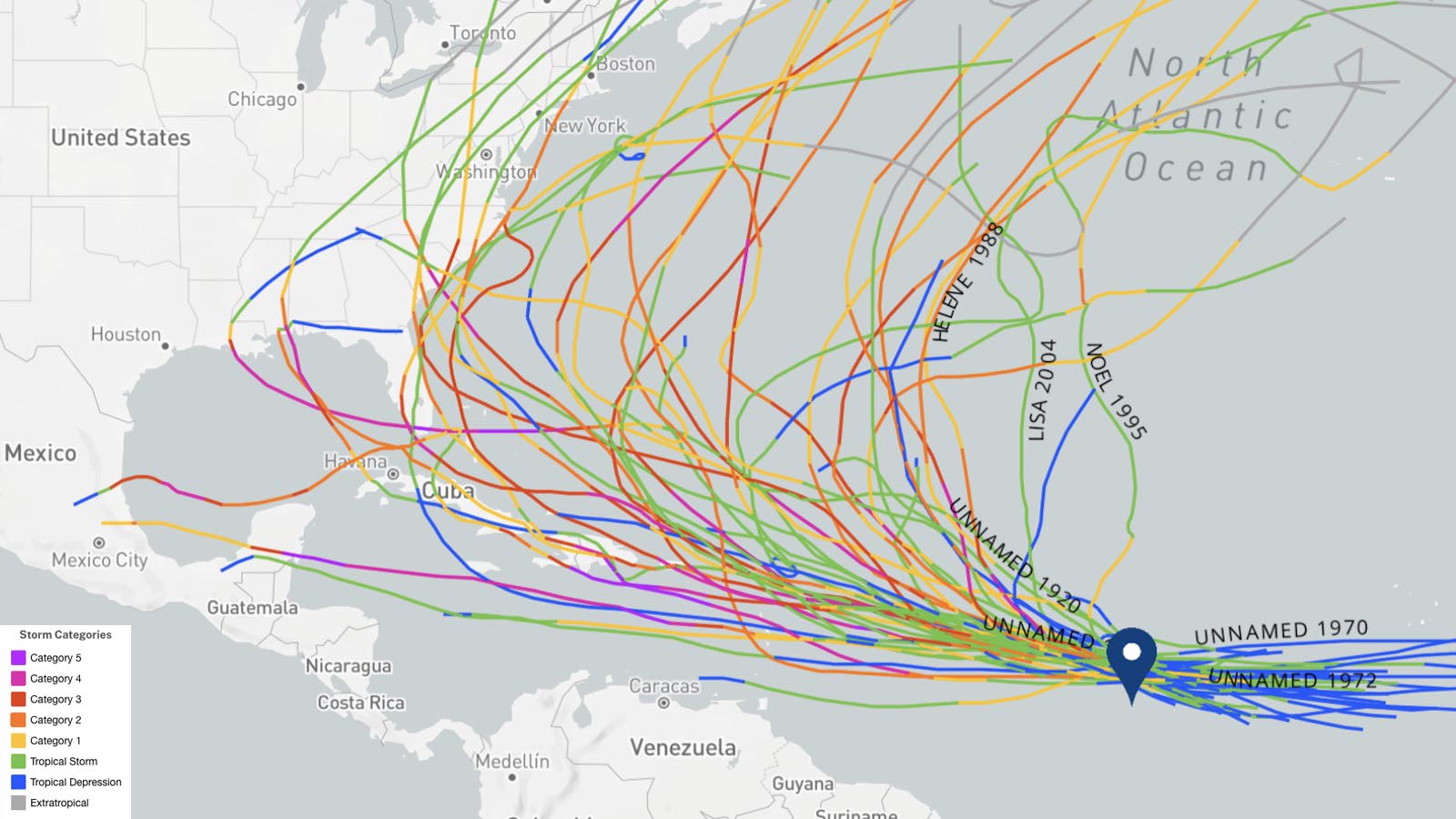Tropical Depression 13 formed in the sultry waters of the eastern Atlantic at 11 a.m. EDT Tuesday, and is likely to intensify into a classic long-track Cabo Verde-type hurricane – the most powerful and dangerous class of Atlantic hurricanes.
At 11 a.m. EDT Tuesday, TD 13 was located about 1425 miles east of the Lesser Antilles Islands, moving west-northwest at 15 mph with top sustained winds of 35 mph and a central pressure of 1008 mb. Satellite images early Tuesday afternoon showed a large system with improving organization, with low-level spiral bands developing and heavy thunderstorm activity growing more concentrated. Given the steadily improving appearance of TD 13, it is likely to be named Tropical Storm Lee later on Tuesday. The first hurricane hunter mission into TD 13 is scheduled for Thursday afternoon.
Track forecast for TD 13
TD 13 is expected to move west-northwest at a steady forward speed of 13 – 15 mph this week, driven by the clockwise circulation around the Azores-Bermuda High to the north. On this track, the system should pass a few hundred miles to the northeast of the northernmost Leeward Islands on Saturday. This would be close enough for the outer spiral bands to bring heavy rains and gusty winds to these islands, but the damaging winds of the eyewall would stay out to sea. However, since these northernmost islands are near the edge of the NHC cone of uncertainty, a direct landfall is still a possibility. NHC is forecasting about a 20-30% chance of tropical storm-force winds in these islands, and a 5-10% chance of hurricane-force winds.
By Monday, a trough of low pressure moving off the eastern coast of North America will likely tug TD 13 sharply to the north, potentially bringing it near Bermuda in the September 13-14 time frame. Beyond that, our long-range forecast skills get unreliable, with the most likely outcomes being an eventual landfall in the Canadian Maritime provinces or recurvature to the northeast, out to sea. A landfall along the U.S. East Coast cannot be dismissed at this time. It is very likely that TD 13 will bring a prolonged period of high surf and dangerous rip currents along the entire eastern seaboard next week and to the northern shores of the islands of the northeastern Caribbean.
Intensity forecast for TD 13
TD 13 currently has favorable conditions for intensification, with warm waters of 29 degrees Celsius (84°F), moderate wind shear of 10-15 knots, and a reasonably moist atmosphere (a mid-level relative humidity around 60%). Conditions will grow increasingly favorable through the week along TD 13’s path, as the system encounters lower wind shear, a moister atmosphere, and steadily warming waters (including an increase in the total heat content of the ocean waters). The intensity models are in unanimous agreement that TD 13 will become a major hurricane by week’s end, and the National Hurricane Center has issued their most aggressive intensity forecast ever for a newly-formed tropical depression: a Category 4 hurricane with 140 mph winds in five days. The previous most aggressive forecast on record was for the eastern Pacific’s Hurricane Rick of 2009: The first NHC forecast predicted a Category 4 storm with 130 mph winds in five days’ time. Rick ultimately intensified into a Category 5 hurricane with 180 mph winds and a 906 mb central pressure, making it the third most intense eastern Pacific hurricane on record. As noted in the Tweet above by Tomer Burg, never before has NHC predicted a Category 4 hurricane with its first forecast for an Atlantic system.
Once TD 13 turns north toward Bermuda next week, conditions for intensification will grow less favorable, as the storm will have to cross the cool water wake left behind by Hurricane Franklin.
Invest 96L off the coast of Africa no threat to land
A tropical wave that moved off the coast of Africa on Tuesday morning was located a few hundred miles south-southeast of the Cabo Verde Islands on Tuesday afternoon. This wave, designated 96L, was headed west-northwest at 10-15 mph, and will bring heavy rains and gusty winds to the Cabo Verde Islands on Wednesday and Thursday. After 96L moves past these islands, no other land areas lie in its projected path, which will take it into the remote central Atlantic. In their 2 p.m. EDT Tuesday Tropical Weather Outlook, NHC gave 96L two-day and seven-day odds of formation of 30% and 70%, respectively. The next name on the Atlantic list of storms after Lee is Margot.
Franklin could be reborn
The remains of Hurricane Franklin, which were swirling a few hundred miles north of the Azores on Tuesday afternoon, are expected to move southeast into warmer waters off the coast of Portugal late this week and merge with an upper-level low that brought catastrophic rains to portions of Spain over the weekend (see our earlier post today on European fires and floods). The relatively warm waters may allow ex-Franklin to regenerate into a tropical or subtropical storm, and in their 2 p.m. EDT Tuesday Tropical Weather Outlook, NHC gave ex-Franklin two-day and seven-day odds of formation of 0% and 20%, respectively.
Website visitors can comment on “Eye on the Storm” posts (see comments policy below). Sign up to receive notices of new postings here.
Source link


